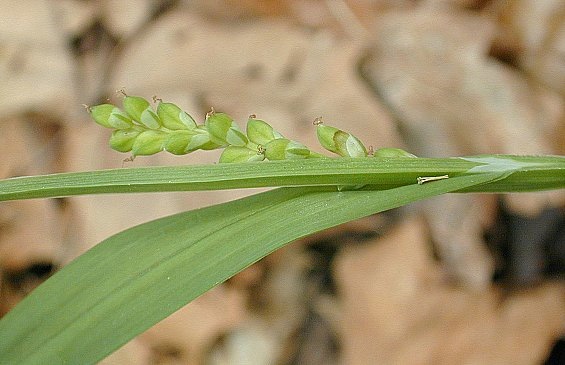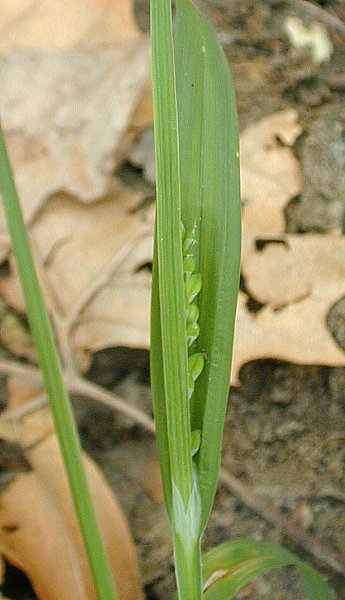Description: This perennial sedge consists of a tuft of basal leaves and culms with alternate leaves; a typical clump of this sedge is about ¾–1' tall and 1–1½' across. The culms are light green, glabrous, triangular, and slightly winged along their margins; their texture is slightly spongy. The blades of the basal leaves are up to 10" long and 1¼" across; they are ascending to widely spreading, pale green, and glabrous. The blades of alternate leaves are similar to the basal leaves, except they are more short and narrow (up to 6½" long and 1/3" across). Relative to the culm, they are usually ascending or arching. The sheaths of alternate leaves are pale green and glabrous along their outer surfaces, while their inner surfaces (opposite from the blades) are white-membranous (at least their upper portions). The sheaths detach rather easily from the ligules. Each culm terminates in an inflorescence consisting of 2-3 pistillate spikelets, a terminal staminate spikelet, and their leafy bracts. This inflorescence frequently leans to one side, even reclining on the ground.

The lower pistillate spikelet has a short stiff peduncle less than ½" long, while the remaining spikelets are nearly sessile. Each pistillate spikelet is about 1–1¼" in length and narrowly cylindrical in shape; it has about 10-15 perigynia and their scales. The staminate spikelet is about ½–¾" in length and very narrow; it is adjacent to the uppermost pistillate spikelet. Immature spikelets are light green, but they become yellow or brown as they age. The leafy bracts are up to 3½" long and 1/3" (8 mm.) across, becoming smaller as they ascend the inflorescence. Each perigynium is about 3.5–4.0 mm. long and 1.8–2.0 mm. across, bluntly 3-angled, and ovoid-obovoid in shape; its apex consists of a short curved beak. The outer surface of each perigynium is hairless and it has several fine veins. The pistillate scales are about 2.5 mm. in length, oval-obovate in shape, and membranous with a green central vein; their upper margins are blunt. The blooming period occurs during mid- to late spring, lasting about 1-2 weeks. The florets are cross-pollinated by the wind. The achenes are 2.0–2.5 mm. long, ovoid-obovoid, bluntly 3-angled, and glabrous. The root system is short-rhizomatous and fibrous.

Cultivation:
The
preference is light to medium shade, moist to slightly dry conditions,
and some protection from prevailing winds. The soil should be
relatively loose and contain some organic matter.
Range & Habitat:
White Bear Sedge is occasional throughout Illinois (see Distribution
Map), where it is native. Habitats include upland woodlands,
wooded slopes, edges of bluffs, and bottoms of ravines. This species is
found in both deciduous and mixed woodlands (coniferous-deciduous),
frequently where calcareous rocky material is present.
It occurs in higher quality natural areas.

Faunal
Associations:
Insects that feed on sedges (Carex
spp.) include leaf beetles, billbugs (Sphenophorus spp.),
plant bugs, aphids, larvae of sawflies, larvae of butterflies (Satyrodes spp.),
larvae of moths, and grasshoppers. The leaf-mining larvae of Clemen's
Cosmopterix Moth (Cosmopterix
clemensella) have been found on White Bear Sedge
specifically. The seeds of sedges are an attractive source of food to
various kinds of birds. For woodland sedges, this would include the
Wild Turkey and chicks of the Ruffed Grouse. Because the broad
basal leaves of this sedge are semi-evergreen and more conspicuous than
those of other sedges, they are more likely to be browsed by
White-Tailed Deer, particularly during the winter.
Photographic Location:
The bottom of a broad ravine in a deciduous woodlands near Charleston,
Illinois.

Comments: Among the broad-leaved Carex spp. (sedges) in Illinois, this one is the most common. It has a distinctive appearance with very broad leaves that are pale green. The odd common name of this sedge derives from the name of a lake in Minnesota; its scientific name is a combination of alba (= white) and ursina (= bear). Generally, one can distinguish White Bear Sedge from other broad-leaved sedges (those with basal leaves exceeding 1" across) by some combination of the following characteristics: 1) the pale color of its foliage, 2) large leafy bracts that exceed the spikelets in length, 3) the curved beaks of its perigynia, and 4) the blunt upper margins of its pistillate scales. Other broad-leaved sedges have darker foliage, bracts that are shorter than the spikelets, perigynia with straight beaks, and/or pistillate scales with pointed tips. In Illinois, the sedges in this small group appear to favor similar habitats (upland woodlands). They are usually quite attractive in appearance.